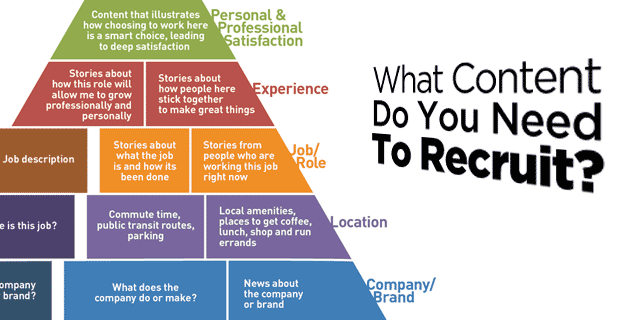Obviously, your job descriptions – those 550-word jargon-rich and meaning-light blurbs – are not getting the job done. You can’t convince anyone who might be at all selective or worth hiring to apply just using those crude devices. So you need to plug the holes in the candidate funnel with content – content that tells your story and gives the best prospects a compelling reason to apply.
But where to start? More to the point, what content do you really need?
Since content is supposed to provide a compelling reason to apply, we need to understand our prospects’ needs. Thus, when establishing a content strategy, it might make sense to go back to the neediest man in social sciences: Abraham Maslow.
Perhaps you remember Mr. Maslow and his Hierarchy of Needs. Perhaps you are remembering that day in high school health class or sociology 101, but this is the idea that humans need things, but they need them in order. That is, you may need love, but you need sleep, food and shelter first.
[pullquote]Start with content that gives a reason for a great candidate to not say “no.”[/pullquote]
So when you are building content for recruiting, you need to think of needs in order. What do candidates need? They need to know that you exist, where you are located and what the job would be.
Luckily, you already have those items of content, unless your entire career site is based on blind postings in the paper. Now, your job description career site probably already has those things, but they really are the bare minimum. As you can see in the infographic above, you can say so much about your company, your location and what the job role really looks like from a day-to-day perspective.
According to Maslow, these are the content elements we need to focus on first. Show not only where the job is, but what the commute’s going to look like, and if there’s parking or public transportation. Talk about the mission of the company, what it strives to do every day, how the prospect may be interacting with the brand and not realize it.
This content isn’t so much compelling as it is giving a reason for a great candidate to not say “no.” You are meeting the bare essentials so that they feel comfortable moving on to more interesting and persuasive content higher up the pyramid.
That content should focus on what the experience of working in this job might feel like. Is it a nine to five or is it start-up hours? Are you serious or fun? What are you serious or fun about? Who are the people they will be reporting to and interacting with on a regular basis? Tell a story about how this team has been through some rough situations, but come out the other side closer and more committed to the company’s goals.
[pullquote]This is really what the best of the best want at work – the chance to achieve personal satisfaction at work. Are you telling them how they will achieve it with you?[/pullquote]
Once you’ve met those needs, you start to think about the very tip of the pyramid: how getting this job will lead to personal and professional satisfaction. This is really what the best of the best want at work – the chance to achieve that satisfaction, either by feeling fulfilled by driving towards a shared goal, building and creating something amazing, or just spending time in the company of like-minded peers.
Illustrating that potential satisfaction isn’t easy, which is why it’s at the top of the hierarchy. In the same way that Maslow put Self-Actualization at the pinnacle of his pyramid, this goal is lofty, perhaps even somewhat elusive. But this is what your content should strive to deliver.
Two notes for those who think they can skip to the end in building recruiting content.
One, you can’t build the top of the pyramid until you’ve built a solid base on which it can rest. Telling a prospect that they will be building amazing things without showing off what the office looks like, what the day-to-day looks like, or what the company mission is will feel like a scam or at the very least sketchy. You need to establish your base before you can reach.
And two, the higher up the hierarchy we went, the more specific to the job and the prospect it got. That means you’ll need to be making hierarchies of content for most roles.
Actually, it’s not as scary as all that, because all your jobs will share the same company-level information, and many roles will share location content. It’s the focus on roles and experiences that becomes more personal, and therefore more compelling.
 So get started building your recruiting content strategy one brick at a time, or else you won’t attract the best candidates.
So get started building your recruiting content strategy one brick at a time, or else you won’t attract the best candidates.
[jetpack_subscription_form title=”Never Miss Another Big Idea” subscribe_text=”Subscribe to Meshworking today! Just enter your email address to get notifications of new posts by email.” subscribe_button=”Sign Me Up”]


0 Comments
1 Pingback